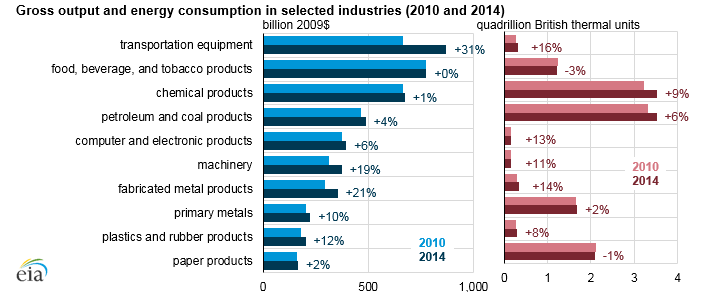Intensity of U.S. Energy Use in Manufacturing Decreased as Output Outpaced Fuel Use

October 19, 2017 - The energy intensity of U.S. manufacturing continued to decrease, according to data released today from the U.S. Energy Information Administration's (EIA) Manufacturing Energy Consumption Survey (MECS). From 2010 to 2014, manufacturing fuel consumption rose 4.7%, while real gross output increased at 9.6%—or more than twice that rate—resulting in a 4.4% decrease in energy intensity.
.png)
Source: U.S. Energy Information Administration, based on Manufacturing Energy Consumption Survey and U.S. Department of Commerce, Bureau of Economic Analysis Gross Domestic Product by Industry
The share of manufacturing output from energy-intensive industries, such as the manufacture of metals, chemicals, paper, and petroleum and coal products, declined between the MECS surveys covering 2010 and 2014, leading to a decline in overall manufacturing energy intensity.
While many manufacturing establishments are taking steps to reduce their energy consumption, the energy intensity decrease for total manufacturing is mostly the result of a shift of manufacturing output to less energy-intensive industries. If major industries had maintained the same proportions of the manufacturing sector, the energy intensity decline between 2010 and 2014 would have been 0.7% instead of 4.4%.
One of the fastest growing industries between 2010 and 2014 was transportation equipment manufacturing, an industry with relatively low energy intensity. Gross output in transportation equipment manufacturing grew 30.8% over that period, much faster than the 9.6% increase in overall manufacturing output between 2010 and 2014.

Source: U.S. Energy Information Administration, Manufacturing Energy Consumption Survey
While output and consumption rose, manufacturing employment decreased from 2010 to 2014, yielding an increase in labor productivity. Manufacturing processes continue to evolve, incorporating more electronic and robotic devices, which may be a primary factor in increased labor productivity.
Total energy used in manufacturing includes both fuel and nonfuel use, such as when natural gas is used a feedstock for chemical manufacturing. Considering fuel use only, natural gas made up a larger share while fuels such as coal and coke, fuel oil, and other petroleum liquids made up smaller shares. Natural gas consumption for manufacturing was 5.9 quadrillion British thermal units (Btu) in 2014, or 39% of the total fuel use in manufacturing, compared with 37% in 2010.
On an economic basis, natural gas has been become more cost competitive with coal and requires fewer expenditures per unit of energy than fuel oil or liquefied petroleum gases.
(1).png)
Source: U.S. Energy Information Administration, Manufacturing Energy Consumption Survey
Like EIA's consumption surveys of the residential and commercial sectors, MECS is conducted on a periodic basis. The latest MECS release provides manufacturing energy consumption, energy expenditures, and other energy-related metrics based on data collected in 2015, which reflects activity in 2014. MECS has been conducted eight times since the initial MECS survey in 1985. The 2014 MECS sample size of approximately 15,000 establishments was drawn from a nationally representative sample frame representing 97% to 98% of the manufacturing payroll.
More information about manufacturing sector's use and management of energy is available in EIA's 2014 Manufacturing Energy Consumption Survey. National and four regional estimates (Northeast, Midwest, South, and West) are provided for 21 industry subsectors, based on the North American Industrial Classification System (NAICS).

